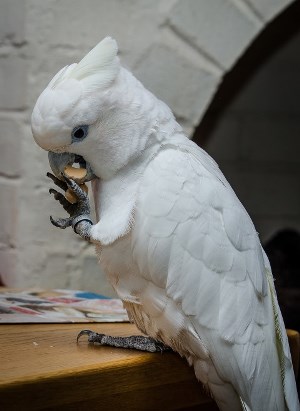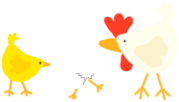Tinkerbell Mash - the best food for your parrot
1 pranešimas
• Puslapis 1 iš 1
For all it is worth.
The best food by far for your parrot will be Tinkerbell mash, a food that you make with love and care for your parrot. No additives or shelf life extenders in it.
Folks had written to me that their birdies who used to pluck stop plucking after they converted over to the mash.
If your birdie has no health reasons to pluck, it might be in the diet among other reasons.
Morning with Harry & the decision// Sultan of Oman Palace// Tinkerbell Mash Batch 7
http://shanlung.livejournal.com/109957.html
Photos below are just a small part of the entire process, rest to be seen above.



You know why the mash I made need to be kept in the freezer?
With only one baggie at a time being thawed and must be kept in the fridge as well?
Whereas what you buy in a box need not be in the freezer? Here is why
Here is the list of the common additives found in pellets.
Do have fun reading that.
Ethoxyquin: Is listed and identified as a harsh hazardous chemical by OSHA. It was originally used to preserve rubber. This is not allowed in human food and some feel it is not a chemical that they want in their bird food. The FDA has asked manufacturers for voluntary reduction in its use in pet foods and is in the process of deciding whether or not to ban the use of it altogether. Bird's bodies can not get rid of it like a dog or cat and it then builds up and causes problems. Ethoxyquin promotes kidney carcinogenesis, significantly increases the incidence of stomach tumors, enhanced bladder carcinogenesis and urinary bladder carcinogenesis. Cancers of this type are the most lethal and fastest acting, the swiftest effects being seen among animals.
Artificial Colors: Most people are aware of toxic side effects of artificial colors and flavors from coal tar derivatives such as Red #40, a possible carcinogen, and Yellow #6, which causes sensitivity to fatal viruses in animals. Artificial colors DO cause yellow feather discoloration in Eclectus.
BHT/BHA: These petroleum products are used to stabilize fats in foods. In the process of metabolizing BHA and BHT, chemical changes occur in the body. These changes have caused reduced growth rates and they inhibit white blood cell stimulation. In pets, they can exhibit reactions such as skin blisters, hemorrhaging of the eye, weakness, discomfort in breathing, a reduction of the body's own antioxidant enzyme, glutathione peroxidase and may cause cancer. According to Dr. Wendell Belfield, DVM, a practicing vet for some 26 years, both BHA and BHT are known to cause liver and kidney dysfunction and are banned in some European countries.
Propylene Glycol: Used as a de-icing fluid for airplanes, this chemical is added to food and skin products to maintain texture and moisture as well as inhibiting bacteria growth in products. It also inhibits the growth of friendly bacteria in the digestive system by decreasing the amount of moisture in the intestinal tract leading to constipation and cancer. It can affect the liver and kidneys and causes the destruction of red blood cells.
Salt: Added as a preservative, salt can irritate the stomach lining, cause increased thirst and aggravate heart and kidney problems through fluid retention.
Sodium Nitrite: Used in the curing of meats, this substance participates in a chemical reaction in the body that becomes carcinogenic. It is used also in pet foods to add color.
Sugar and other Sweeteners: The most common sweeteners in pet/bird foods are beet sugar, corn sugar, molasses and sucrose. They are used as preservatives and have the side effect of creating sugar addicts in pets. They require almost no digestion and are rapidly absorbed into the blood stream. These will provide sugar highs (just as humans experience) and subsequent lows (moodiness), inhibit the proper growth of friendly intestinal bacteria and they virtually shut down the digestive system while being processed. Sugar can also contribute to diabetes and hypoglycemia, cataract development, obesity and arthritis.
Further variation on that mash batch 7.
I believe the mash can remain good for the entire day. At least in Riamfada's room kept at 24-25C.
Read the report done on 11 & 14 June 2010 and you decide for yourself.
Month of soccer // Cyclone Phet & Riamfada neighbourhood hide & seek // Mash eating
http://shanlung.livejournal.com/115514.html
Hand of Clod //3 hour and day old Mash // Outdoor hide&seek recalls
http://shanlung.livejournal.com/115814.html
See also the making of Tinkerbell mash batch 8
with changes and further improvement on batch 7
Iceland and Goldman // Jebel Akhdar // Tinkerbell mash batch 8
http://shanlung.livejournal.com/114545.html
see the making of Tinkerbell Mash Batch 9
with changes and further improvement on batch 8
Pakistan//mind of parrot//Tinkerbell Mash Batch 9//Riamfada pulling up cup//Villa walkabout
http://shanlung.livejournal.com/119016.html
and kitty mash as well, which I now use for my insectivore/omnivore birdie
Pakistan//Tinkerbell Kitty Mash//Dommie at the beach Ramadhan 2010 //Villa walkabout 2
http://shanlung.livejournal.com/119237.html
The best food by far for your parrot will be Tinkerbell mash, a food that you make with love and care for your parrot. No additives or shelf life extenders in it.
Folks had written to me that their birdies who used to pluck stop plucking after they converted over to the mash.
If your birdie has no health reasons to pluck, it might be in the diet among other reasons.
Morning with Harry & the decision// Sultan of Oman Palace// Tinkerbell Mash Batch 7
http://shanlung.livejournal.com/109957.html
Photos below are just a small part of the entire process, rest to be seen above.



You know why the mash I made need to be kept in the freezer?
With only one baggie at a time being thawed and must be kept in the fridge as well?
Whereas what you buy in a box need not be in the freezer? Here is why
Here is the list of the common additives found in pellets.
Do have fun reading that.
Ethoxyquin: Is listed and identified as a harsh hazardous chemical by OSHA. It was originally used to preserve rubber. This is not allowed in human food and some feel it is not a chemical that they want in their bird food. The FDA has asked manufacturers for voluntary reduction in its use in pet foods and is in the process of deciding whether or not to ban the use of it altogether. Bird's bodies can not get rid of it like a dog or cat and it then builds up and causes problems. Ethoxyquin promotes kidney carcinogenesis, significantly increases the incidence of stomach tumors, enhanced bladder carcinogenesis and urinary bladder carcinogenesis. Cancers of this type are the most lethal and fastest acting, the swiftest effects being seen among animals.
Artificial Colors: Most people are aware of toxic side effects of artificial colors and flavors from coal tar derivatives such as Red #40, a possible carcinogen, and Yellow #6, which causes sensitivity to fatal viruses in animals. Artificial colors DO cause yellow feather discoloration in Eclectus.
BHT/BHA: These petroleum products are used to stabilize fats in foods. In the process of metabolizing BHA and BHT, chemical changes occur in the body. These changes have caused reduced growth rates and they inhibit white blood cell stimulation. In pets, they can exhibit reactions such as skin blisters, hemorrhaging of the eye, weakness, discomfort in breathing, a reduction of the body's own antioxidant enzyme, glutathione peroxidase and may cause cancer. According to Dr. Wendell Belfield, DVM, a practicing vet for some 26 years, both BHA and BHT are known to cause liver and kidney dysfunction and are banned in some European countries.
Propylene Glycol: Used as a de-icing fluid for airplanes, this chemical is added to food and skin products to maintain texture and moisture as well as inhibiting bacteria growth in products. It also inhibits the growth of friendly bacteria in the digestive system by decreasing the amount of moisture in the intestinal tract leading to constipation and cancer. It can affect the liver and kidneys and causes the destruction of red blood cells.
Salt: Added as a preservative, salt can irritate the stomach lining, cause increased thirst and aggravate heart and kidney problems through fluid retention.
Sodium Nitrite: Used in the curing of meats, this substance participates in a chemical reaction in the body that becomes carcinogenic. It is used also in pet foods to add color.
Sugar and other Sweeteners: The most common sweeteners in pet/bird foods are beet sugar, corn sugar, molasses and sucrose. They are used as preservatives and have the side effect of creating sugar addicts in pets. They require almost no digestion and are rapidly absorbed into the blood stream. These will provide sugar highs (just as humans experience) and subsequent lows (moodiness), inhibit the proper growth of friendly intestinal bacteria and they virtually shut down the digestive system while being processed. Sugar can also contribute to diabetes and hypoglycemia, cataract development, obesity and arthritis.
Further variation on that mash batch 7.
I believe the mash can remain good for the entire day. At least in Riamfada's room kept at 24-25C.
Read the report done on 11 & 14 June 2010 and you decide for yourself.
Month of soccer // Cyclone Phet & Riamfada neighbourhood hide & seek // Mash eating
http://shanlung.livejournal.com/115514.html
Hand of Clod //3 hour and day old Mash // Outdoor hide&seek recalls
http://shanlung.livejournal.com/115814.html
See also the making of Tinkerbell mash batch 8
with changes and further improvement on batch 7
Iceland and Goldman // Jebel Akhdar // Tinkerbell mash batch 8
http://shanlung.livejournal.com/114545.html
see the making of Tinkerbell Mash Batch 9
with changes and further improvement on batch 8
Pakistan//mind of parrot//Tinkerbell Mash Batch 9//Riamfada pulling up cup//Villa walkabout
http://shanlung.livejournal.com/119016.html
and kitty mash as well, which I now use for my insectivore/omnivore birdie
Pakistan//Tinkerbell Kitty Mash//Dommie at the beach Ramadhan 2010 //Villa walkabout 2
http://shanlung.livejournal.com/119237.html
-

shanlung - Pranešimai: 15
- Užsiregistravo: 2007.06.16 01:32
1 pranešimas
• Puslapis 1 iš 1
Dabar prisijungę
Vartotojai naršantys šį forumą: Registruotų vartotojų nėra ir 14 svečių




